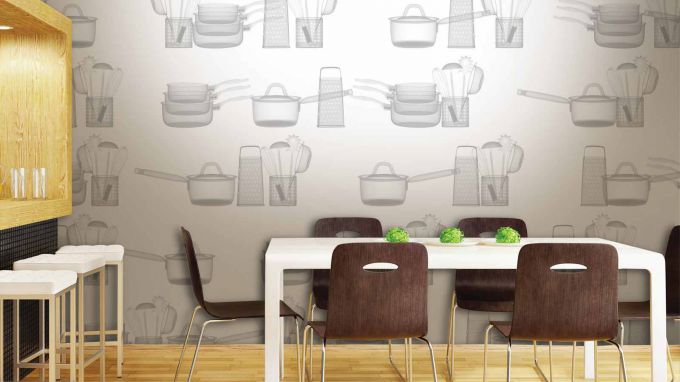Good version of the Wallpapers for kitchen — vinyl Wallpaper. They are durable, moisture-resistant, retain their color for a long time, they can be washed, and some even with detergents. The shops provide a huge number of vinyl Wallpaper. Relief, imitating fabrics, textured plaster, vinyl Wallpaper is perfect for kitchen design and hide small irregularities on the wall.
For newcomers to the repair is perfect vinyl Wallpaper on the basis of the nonwoven fabric. For stickers these Wallpaper glue should be applied only on the wall, which will greatly reduce the dirt in the repair, and save the amount of glue. This Wallpaper is not deformed in the process of stickers, they can mash, then they are perfectly smooth on the wall.
Non-woven Wallpaper are more expensive. Interlining is a nonwoven material with the addition of polyester.
The top silk layer is made of silk threads. Screen printing is easy to wash, it is a long time not fade and gives the walls a more elegant look.
Fiberglass is made from fiberglass. They quickly break, are not erased and do not burn. With fiberglass can hide cracks and prevent new ones. Unlike conventional vinyl Wallpaper, glass "breathe", thanks to the good vapor resistance under them does not start flexible, they are hypoallergenic. Tolerate painting, repaint the fiberglass can be many times.
It is not necessary to glue on kitchen paper Wallpaper. They are very fragile, burn out quickly and absorb odors. For the same reasons, it is not necessary to use the Wallpapers from natural materials. Acrylic Wallpaper when cleaning can be easily damaged, and they will lose.
When choosing colors and pattern for kitchen the same considerations as for the selection of the Wallpaper in other parts of the apartment. Bright colors excite and irritate. Pastel colors calm and relax. In bright rooms it is better to use cold colors (blue, silver, gray, pink), but if light is insufficient, it is better to use warm colors (orange, gold, peach, light green). For smaller rooms use a small figure to large is a large. Vertical stripe — raises the ceiling, but visually narrows the space, horizontal — extends the wall, but reduces the ceiling.
